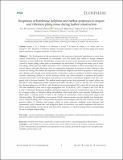Files in this item
Responses of bottlenose dolphins and harbor porpoises to impact and vibration piling noise during harbor construction
Item metadata
| dc.contributor.author | Graham, Isla | |
| dc.contributor.author | Pirotta, Enrico | |
| dc.contributor.author | Merchant, Nathan | |
| dc.contributor.author | Farcas, Adrian | |
| dc.contributor.author | Barton, Tim | |
| dc.contributor.author | Cheney, Barbara | |
| dc.contributor.author | Hastie, Gordon D. | |
| dc.contributor.author | Thompson, Paul | |
| dc.date.accessioned | 2017-05-30T14:30:08Z | |
| dc.date.available | 2017-05-30T14:30:08Z | |
| dc.date.issued | 2017-05 | |
| dc.identifier | 249468009 | |
| dc.identifier | ac015a56-be9a-4ca6-8698-194fbcf9a877 | |
| dc.identifier | 85019996152 | |
| dc.identifier | 000402472300034 | |
| dc.identifier.citation | Graham , I , Pirotta , E , Merchant , N , Farcas , A , Barton , T , Cheney , B , Hastie , G D & Thompson , P 2017 , ' Responses of bottlenose dolphins and harbor porpoises to impact and vibration piling noise during harbor construction ' , Ecosphere , vol. 8 , no. 5 , e01793 . https://doi.org/10.1002/ecs2.1793 | en |
| dc.identifier.issn | 2150-8925 | |
| dc.identifier.other | ORCID: /0000-0002-9773-2755/work/54819188 | |
| dc.identifier.uri | https://hdl.handle.net/10023/10877 | |
| dc.description | This project was funded through the DECC Offshore Energy Strategic Environmental Assessment Programme using equipment previously purchased by DECC, Scottish Government, Oil and Gas UK, COWRIE and Moray Offshore Renewables Ltd. Scottish Natural Heritage, Beatrice Offshore Windfarm Ltd., MORL, Marine Scotland, The Crown Estate and Highlands and Islands Enterprise all provided funding for photo-identification surveys. Data have been made available in the Dryad repository at https://doi.org/10.5061/dryad.g3603. | en |
| dc.description.abstract | The development of risk assessments for the exposure of protected populations to noise from coastal construction is constrained by uncertainty over the nature and extent of marine mammal responses to man-made noise. Stakeholder concern often focuses on the potential for local displacement caused by impact piling, where piles are hammered into the seabed. To mitigate this threat, use of vibration piling, where piles are shaken into place with a vibratory hammer, is often encouraged due to presumed impact reduction. However, data on comparative responses of cetaceans to these different noise sources are lacking. We studied the responses of bottlenose dolphins and harbor porpoises to both impact and vibration pile driving noise during harbor construction works in northeast Scotland, using passive acoustic monitoring devices to record cetacean activity and noise recorders to measure and predict received noise levels. Local abundance and patterns of occurrence of bottlenose dolphins were also compared with a five-year baseline. The median peak-to-peak source level estimated for impact piling was 240 dB re 1 μPa (single-pulse sound exposure level [SEL] 198 dB re 1 μPa2 s), and the r.m.s. source level for vibration piling was 192 dB re 1 μPa. Predicted received broadband SEL values 812 m from the piling site were markedly lower due to high propagation loss: 133.4 dB re 1 μPa2 s (impact) and 128.9 dB re 1 μPa2 s (vibration). Bottlenose dolphins and harbor porpoises were not excluded from sites in the vicinity of impact piling or vibration piling; nevertheless, some small effects were detected. Bottlenose dolphins spent a reduced period of time in the vicinity of construction works during both impact and vibration piling. The probability of occurrence of both cetacean species was also slightly less during periods of vibration piling. This work provides developers and managers with the first evidence of the comparative effects of vibration and impact piling on small cetaceans, enabling more informed risk assessments, policy frameworks, and mitigation plans. In particular, our results emphasize the need for better understanding of noise levels and behavioral responses to vibration piling before recommending its use to mitigate impact piling. | |
| dc.format.extent | 16 | |
| dc.format.extent | 2673409 | |
| dc.language.iso | eng | |
| dc.relation.ispartof | Ecosphere | en |
| dc.subject | Acoustic disturbance | en |
| dc.subject | Anthropogenic noise | en |
| dc.subject | Behavioral response | en |
| dc.subject | Coastal development | en |
| dc.subject | Environmental risk assessment | en |
| dc.subject | Marine mammal conservation | en |
| dc.subject | Marine protected area | en |
| dc.subject | QH301 Biology | en |
| dc.subject | GE Environmental Sciences | en |
| dc.subject | GC Oceanography | en |
| dc.subject | SH Aquaculture. Fisheries. Angling | en |
| dc.subject | DAS | en |
| dc.subject | NERC | en |
| dc.subject | SDG 14 - Life Below Water | en |
| dc.subject.lcc | QH301 | en |
| dc.subject.lcc | GE | en |
| dc.subject.lcc | GC | en |
| dc.subject.lcc | SH | en |
| dc.title | Responses of bottlenose dolphins and harbor porpoises to impact and vibration piling noise during harbor construction | en |
| dc.type | Journal article | en |
| dc.contributor.institution | University of St Andrews. School of Biology | en |
| dc.contributor.institution | University of St Andrews. Sea Mammal Research Unit | en |
| dc.identifier.doi | 10.1002/ecs2.1793 | |
| dc.description.status | Peer reviewed | en |
This item appears in the following Collection(s)
Items in the St Andrews Research Repository are protected by copyright, with all rights reserved, unless otherwise indicated.

